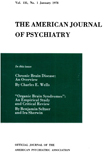PROBLEMS IN APPLICATION OF THE BASIC CRITERIA OF SCHIZOPHRENIA
Abstract
Four cases were diagnosed as schizophrenic by careful observation and documentation. The patients had the following in common:
1. By all symptoms no schizophrenia was immediately apparent. It required time and attention to establish the diagnosis in all cases. But then it remained firmly established by the basic accepted criteria.
2. The patients were persons of good intelligence and had other assets as well. They tended to mobilize many mechanisms of defense as "ego" structure threatened to "weaken" further. These consisted both of additional neurotic defenses and some tendency toward "acting-out," but no change was manifested in areas considered schizophrenic.
Therefore, we are considering a category of individuals who belong to the group of schizophrenias according to legitimate definition, but apparently no more capable of disorganization, or display of blatant "accessory" symptoms, than the next person.
In each of these instances, schizophrenic psychopathology comprised one part of the total picture, but did not thereby characterize the case. This concept differs from Hoch's "pseudoneurotic schizophrenia" (9) in that the latter describes an illness which is schizophrenic for all important clinical purposes: disorganization potential, therapeutic technique required, goals of therapy, and prognosis. By way of contrast, perhaps the best diagnostic approach to the above "pseudoschizophrenic neurotic" cases is the one or two paragraph description of psychopathology, with all factors evaluated on an individual basis.
Access content
To read the fulltext, please use one of the options below to sign in or purchase access.- Personal login
- Institutional Login
- Sign in via OpenAthens
- Register for access
-
Please login/register if you wish to pair your device and check access availability.
Not a subscriber?
PsychiatryOnline subscription options offer access to the DSM-5 library, books, journals, CME, and patient resources. This all-in-one virtual library provides psychiatrists and mental health professionals with key resources for diagnosis, treatment, research, and professional development.
Need more help? PsychiatryOnline Customer Service may be reached by emailing [email protected] or by calling 800-368-5777 (in the U.S.) or 703-907-7322 (outside the U.S.).



